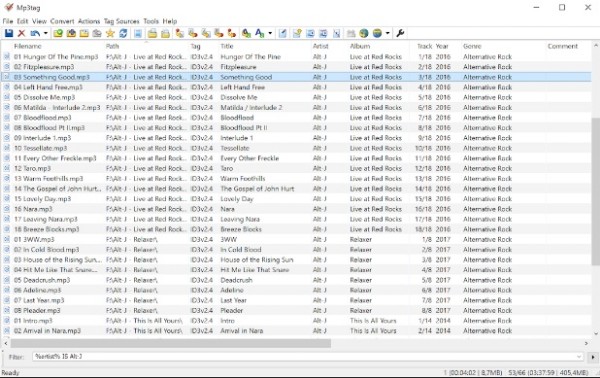

No learning curve will be required even if you are a beginner user as the utility is intuitive enough. It consists of vital information such as Basic Info, Artwork, ID3v1, and ID3v2 that you can seamlessly switch depending on your needs. Upon launching, a tabbed-application appearance will greet you.
#MUSIC TAG EDITOR INSTALL#
sample/440Hz.Free Mp3 Tag Editor offers a neat and streamlined interface that's also quick and lightweight to install in your desktop system.

Python -m music_tag -set "genre:Pop" -set "comment:cli test" \. Setting Tags # Set a couple tags for multiple files Python -m music_tag -tags = "Title : Album" -to-csv tags.csv. # Write specific tags from all audio files in sample directory to a csv file # Write tags from all audio files in sample directory to a csv file Python -m music_tag -print -tags = "Title : Album". # Print specific tags from all audio files in sample directory Here are someĮxamples, Printing Tags # Print tags from all audio files in sample directory The music_tag package can be used as a CLI to get / set tags. resolve ( 'compilation' ) # <- False Command Line Tool resolve ( 'compilation' ) # <- True f = 'Brian' f. resolve ( 'album artist' ) # <- 'Various Artists' del f f = 'Various Artists' f. resolve ( 'album artist' ) # <- 'Brian' f = True f. resolve ( 'album artist' ) # <- 'Brian' f = 'Brian' del f f = False f. For instance, the album artist tag is probablyĮqual to the artist tag, or "Various Artists" if the compilationįlag is set. Some tags may not exist in a file, but there could be enough information toĭiscern the correct value. This is ugly, but you can use the file object's raw property if you like To enable things like leading zeros in tracknumbers (i.e., track '01'). Some tag formats store everything as strings For instance, track numbersĪnd years are return as integers. save () Skipping Type Normalizationīy default, tags are validated and normalized. ' Saving tags # finally, you can bounce the edits to disk f. read ()) # Make a thumbnail (requires Pillow) art. read () with open ( 'music_tag/test/sample/imgB.jpg', 'rb' ) as img_in : f. ' # set artwork with open ( 'music_tag/test/sample/imgA.jpg', 'rb' ) as img_in : f = img_in. You can also # use ``art.first``, or iterate through ``art.values``. This will raise a # ValueError if there is more than one image. Use ``art.value`` if there is # only one image embeded in the file. # get artwork art = f # Note: `art` is a MetadataItem. Requires the Pillow (modern day PIL) library. remove_tag ( 'title' ) Album artworkĪlbum artwork is wrapped in an object that keeps track of some of theĮxtra metadata associated with images. value # -> '440Hz, subtitle' str ( title_item ) # -> '440Hz, subtitle' Removing tags del f f. append_tag ( 'title', 'subtitle' ) title_item. value # -> '440Hz' # MetadataItems can also be cast to a string str ( title_item ) # -> '440Hz' Setting tags # tags can be set as if the file were a dictionary f = '440Hz' # additional values can be appended to the tags f. values # -> # A single value can be extracted title_item. load_file ( "music-tag/sample/440Hz.m4a" ) # dict access returns a MetadataItem title_item = f # MetadataItems keep track of multi-valued keys title_item. Also, disk is synonymous with disc.Įxamples Reading tags import music_tag f = music_tag.

In other words, Album Artist, album-artist, andĪlbum_artist are all synonyms for albumartist. Keys are not case sensitive and can contain arbitrary whitespace, '-', and '_'Ĭharacters. Metadata is available using a dictionary-like interface with the following keys. The following file formats are actively tested. Mp3 files shouldn not be any different than flac, m4a. That does not depend on the underlying file format. Music-tag is a library for editing audio metadata with an interface


 0 kommentar(er)
0 kommentar(er)
